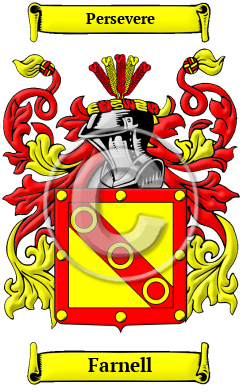| ![Show Contents]() Farnell History, Family Crest & Coats of Arms Farnell History, Family Crest & Coats of Arms
Etymology of FarnellWhat does the name Farnell mean? The Anglo-Saxon name Farnell comes from the family having resided by a fern-covered hill. The name is both a surname and a place-name, and is derived from the Old English elements fearn, for fern, and hyll, the word for hill. 1 Alternatively, another source notes that the surname denotes a "dweller at the Fern Slope or Corner [Old English fearn + heal(h)] for Farnhill." 2 Early Origins of the Farnell familyThe surname Farnell was first found in East Cheshire at Fernhill, or at Farnhill in West Riding of Yorkshire or at Farnell Wood in Kent. Some of the first records of the name include: Richard de Farenhull in 1214; William de Fernhulle in 1263 and Hugh de la Fernhull in 1275; John de Farnhull, listed in the Hundredorum Rolls of 1273; and William atte Farnhulle in 1298. 1 In Scotland, the name was derived from "the lands of Famell in Angus. Between 1214 and 1246 Duncan de Ferneuel witnessed charters by Malcolm, earl of Angus, and a charter of land in the territory of Kerimor to Arbroath Abbey. Meg Fernwale is recorded in Aberdeen, 1408." 3 Early History of the Farnell familyThis web page shows only a small excerpt of our Farnell research. Another 116 words (8 lines of text) covering the years 1200, 1246 and 1379 are included under the topic Early Farnell History in all our PDF Extended History products and printed products wherever possible. Farnell Spelling VariationsFarnell has been spelled many different ways. Before English spelling became standardized over the last few hundred years, spelling variations in names were a common occurrence. As the English language changed in the Middle Ages, absorbing pieces of Latin and French, as well as other languages, the spelling of people's names also changed considerably, even over a single lifetime. Spelling variants included: Farnell, Farnel, Farnall, Farnyll, Farnill and many more. Early Notables of the Farnell familyDistinguished members of the family include
| Farnell migration to the United States | + |
In an attempt to escape the chaos experienced in England, many English families boarded overcrowded and diseased ships sailing for the shores of North America and other British colonies. Those families hardy enough, and lucky enough, to make the passage intact were rewarded with land and a social environment less prone to religious and political persecution. Many of these families became important contributors to the young colonies in which they settled. Early immigration and passenger lists have documented some of the first Farnells to arrive on North American shores:
Farnell Settlers in United States in the 17th Century- Robert Farnell, aged 31, who arrived in Virginia aboard the ship "London Merchant" in 1619
- Mary Farnell also landed in Virginia, later, in 1655
- Mary Farnell, who arrived in Virginia in 1655 4
| Farnell migration to New Zealand | + |
Emigration to New Zealand followed in the footsteps of the European explorers, such as Captain Cook (1769-70): first came sealers, whalers, missionaries, and traders. By 1838, the British New Zealand Company had begun buying land from the Maori tribes, and selling it to settlers, and, after the Treaty of Waitangi in 1840, many British families set out on the arduous six month journey from Britain to Aotearoa to start a new life. Early immigrants include: Farnell Settlers in New Zealand in the 19th Century- Mr. James Farnell, (b. 1850), aged 25, Scottish settler travelling from Glasgow aboard the ship "Peter Denny" arriving in Bluff, Southland, South Island, New Zealand on 25th November 1875 5
| Contemporary Notables of the name Farnell (post 1700) | + |
- Anthony "Woodhouse Warrior" Farnell, English boxer, brought up in Failsworth, Oldham and is a former WBU middleweight champion
- James Squire Farnell (1825-1888), Australian politician and Premier of New South Wales
- Frank Farnell, Australian politician, elected as a member of the New South Wales Legislative Assembly
- Rear-Admiral Kenneth Farnell, British naval officer awarded the Order of the British Empire for distinguished service in World War II
The motto was originally a war cry or slogan. Mottoes first began to be shown with arms in the 14th and 15th centuries, but were not in general use until the 17th century. Thus the oldest coats of arms generally do not include a motto. Mottoes seldom form part of the grant of arms: Under most heraldic authorities, a motto is an optional component of the coat of arms, and can be added to or changed at will; many families have chosen not to display a motto.
Motto: Persevere
- Reaney, P.H and R.M. Wilson, A Dictionary of English Surnames. London: Routledge, 1991. Print. (ISBN 0-415-05737-X)
- Harrison, Henry, Surnames of the United Kingdom: A Concise Etymological Dictionary Baltimore: Geneological Publishing Company, 2013. Print
- Black, George F., The Surnames of Scotland Their Origin, Meaning and History. New York: New York Public Library, 1946. Print. (ISBN 0-87104-172-3)
- Filby, P. William, Meyer, Mary K., Passenger and immigration lists index : a guide to published arrival records of about 500,000 passengers who came to the United States and Canada in the seventeenth, eighteenth, and nineteenth centuries. 1982-1985 Cumulated Supplements in Four Volumes Detroit, Mich. : Gale Research Co., 1985, Print (ISBN 0-8103-1795-8)
- New Zealand Yesteryears Passenger Lists 1800 to 1900 (Retrieved 26th March 2019). Retrieved from http://www.yesteryears.co.nz/shipping/passlist.html
 |

